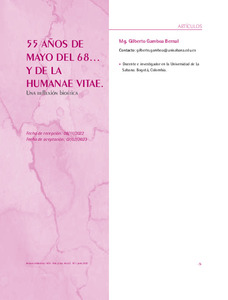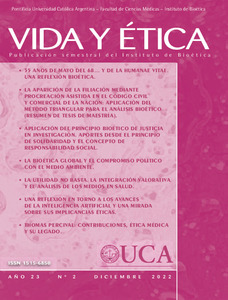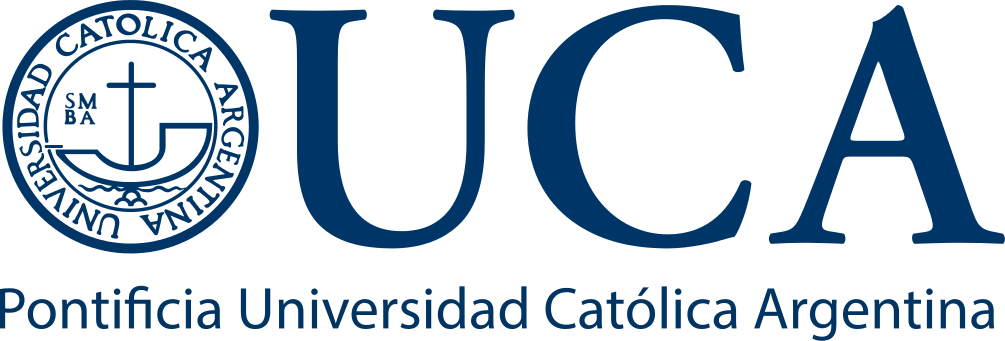Por favor, use este identificador para citar o enlazar este ítem:
https://repositorio.uca.edu.ar/handle/123456789/16454| Campo DC | Valor | Lengua/Idioma |
|---|---|---|
| dc.contributor.author | Gamboa Bernal, Gilberto A. | es |
| dc.date.accessioned | 2023-06-01T12:53:08Z | - |
| dc.date.available | 2023-06-01T12:53:08Z | - |
| dc.date.issued | 2022 | - |
| dc.identifier.citation | Gamboa Bernal, G. A. 55 años de mayo del 68… y de la Humanae Vitae: una reflexión bioética [en línea]. Vida y Etica. 2022, 23 (2). Disponible en: https://repositorio.uca.edu.ar/handle/123456789/16454 | es |
| dc.identifier.issn | 1515-6850 (impreso) | - |
| dc.identifier.issn | 2683-6998 (online) | - |
| dc.identifier.uri | https://repositorio.uca.edu.ar/handle/123456789/16454 | - |
| dc.description.abstract | Resumen: En 1968 ocurrieron dos hechos sobre los cuales cabe hacer una reflexión orientada por la bioética: la llamada Revolución del 68 y la aparición de la Carta encíclica Humanae Vitae. El Concilio Vaticano II, que fue presentado como una actualización de la Iglesia católica al mundo moderno, fue el escenario de los estudios previos a la redacción del documento pontificio, donde Pablo VI dejó clara la postura del Magisterio de la Iglesia sobre la moral sexual y anticipa los errores prácticos que se seguirían a planteamientos conceptuales antropológicos erróneos o equivocados sobre esa temática. Hay necesidad de rehabilitar la Humanae vitae para volver a percibir el acto conyugal en su “verdad inalterable”, donde no se puede separar el bien y la belleza de la donación mutua de los cónyuges, que redunda en el bien común de la sociedad para defender su célula básica y nuclear que es la familia. | es |
| dc.description.abstract | Abstract: In 1968, two events occurred on which it is worth reflecting on bioethics: the so-called Revolution of 1968 and the appearance of the Encyclical Letter Humanae Vitae. The Second Vatican Council, which was presented as an update of the Catholic Church to the modern world, was the scene of the studies prior to the drafting of the pontifical document, where Paul VI made clear the position of the Magisterium of the Church on sexual morality and it anticipates the practical errors that would follow erroneous or mistaken anthropological conceptual approaches on this subject. There is a need to rehabilitate Humanae vitae in order to re-perceive the conjugal act in its “unalterable truth”, where good and beauty cannot be separated from the mutual donation of the spouses, which results in the common good of society to defend its basic and nuclear cell which is the family. | es |
| dc.format | application/pdf | es |
| dc.language.iso | spa | es |
| dc.publisher | Educa | es |
| dc.rights | Acceso abierto | * |
| dc.rights.uri | http://creativecommons.org/licenses/by-nc-sa/4.0/ | * |
| dc.source | Vida y Etica Año 23, No.2, 2022 | es |
| dc.subject | Humanae Vitae | es |
| dc.subject | ENCICLICAS | es |
| dc.subject | BIOETICA | es |
| dc.subject | METODOS ANTICONCEPTIVOS | es |
| dc.subject | NATURALEZA HUMANA | es |
| dc.subject | SEXUALIDAD | es |
| dc.title | 55 años de mayo del 68… y de la Humanae Vitae: una reflexión bioética | es |
| dc.type | Artículo | es |
| uca.disciplina | BIOETICA | es |
| uca.issnrd | 1 | es |
| uca.affiliation | Fil: Gamboa Bernal, Gilberto A. Universidad de La Sabana; Colombia. | es |
| uca.version | publishedVersion | es |
| item.fulltext | With Fulltext | - |
| item.grantfulltext | open | - |
| item.languageiso639-1 | es | - |
| Aparece en las colecciones: | VE - 2022 Año 23 nro. 2 | |
Ficheros en este ítem:
| Fichero | Descripción | Tamaño | Formato | |
|---|---|---|---|---|
| 55-años-mayo-68.pdf | 114,25 kB | Adobe PDF |  Visualizar/Abrir | |
| vidayetica2022-2-portada.pdf | 114,68 kB | Adobe PDF |  Visualizar/Abrir |
Visualizaciones de página(s)
60
comprobado en 27-abr-2024
Descarga(s)
71
comprobado en 27-abr-2024
Google ScholarTM
Ver en Google Scholar
Este ítem está sujeto a una Licencia Creative Commons

